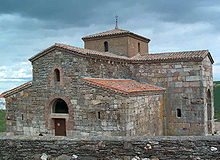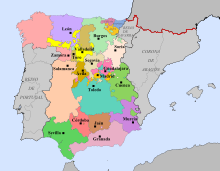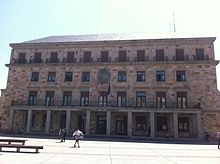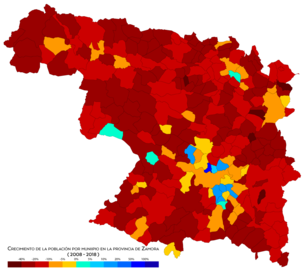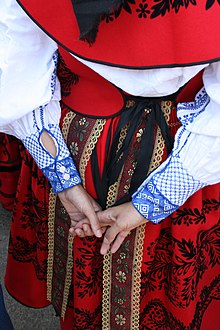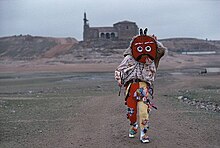Zamora Province
Zamora is a northwestern Spanish province of the autonomous community of Castilla y León, whose capital and most populous city is Zamora.
It has an area of 10,561 km², which represents 2.1% of the surface of Spain, and is located between the parallels 41° 8' and 42º 15' N and the meridians 5° 15' and 7° 02' W, based on the Greenwich meridian. On January 1, 2022, it had a total population of 167,215 inhabitants. It limits to the north with the province of León, to the east with the province of Valladolid, to the south with Salamanca, and to the west with Portugal and with Galicia at the height of the province of Orense.
The province has 520 population centers, grouped into 248 municipalities, of which more than half have less than 250 inhabitants, sixteen of them have more than 1,000 inhabitants and only Benavente, Toro and Zamora capital have more than 5,000 population.
As such, it was constituted in the territorial division of Spain in 1833, after the reforms carried out by Javier de Burgos, forming part, although without administrative operation, of the region of León. It is divided into 248 municipalities, grouped together in five judicial districts: Toro, Zamora, Benavente, Sanabria and Villalpando.
Toponymy
The province of Zamora takes its name from the city of Zamora, its provincial capital. There is no unanimity about the origin of this name. For some, its first name would be Roman, being cited in the Antonino Itinerary under the name Ocellum Duri (Los Ojos del Duero), of which, by a kind of acronym (ce-m-uri), would result in the current name. Its origin, therefore, could be one of the classic mansions that flanked the Roman roads of the time, in this case the Vía de la Plata. In 569, already in the middle of the Visigothic period, the enclave was mentioned under the name of Semure, changing its name to Azemur (wild olive grove) or سمورة Samura during Muslim rule. After the Reconquest, around the year 754, by King Alfonso I of Asturias and after being rebuilt and repopulated by King Ferdinand I of León (1010-1065) in the XI, is renamed Zamora.
Symbols
Shield
The coat of arms of the province of Zamora has the following heraldic description:
Shield divided into seven quarters:
- In the first barracks, in the first gold, a rampant and contoured bull in its color, the second silver, a rampant lion of gules, a synople tablecloth that is the shield of Toro.
- In the second, of silver, a bridge of silver mamposted gold of sable and summit of the image of the Virgin Mary with the Child, surrounded on its right and sinister of a tower, of the same metal (color), mamposteada of sable and cleared of gules that is that of Benavente.
- In the third, the Spanish blazon is made with eight strips of sugar and gold, a golden sun with rays of the same metal that is Villalpando's.
- In the room, clothed, in the first and second, of gules, a mamposteada gold tower of sable, silver tablecloth, a rampant lion of gules that is the one of Alcañices.
- In the fifth, of azur, a cross of San Andrés gold, accompanied by four lises of the same metal placed in aspa, azur embroidery loaded with eight growing ones that is Puebla de Sanabria.
- In the sixth, of gold, a castle of the same mooring of three hives, mamposted of sable that is the Bermillo of Sayago.
- In the seventh, of silver, a bicephalous eagle of saber surpassed from a real crown closed and accompanied on its right hand and sinister of a banner that is the one of Fuentesaúco.
Above the entire broken escutcheon, made of silver, an arm armed with the same carrying a flag draped in gules and, also made of silver and terraced with sínople, a silver bridge, masonry with sable and surrounded by two towers on waves of azur and silver that is the shield of the City of Zamora. At the buzzer, royal crown closed. The shield includes the shields of the municipalities that were the head of the Judicial Party. Currently, only the districts of Benavente, Puebla de Sanabria, Toro, Villalpando and Zamora exist, those of Fuentesaúco, Alcañices and Bermillo were suppressed.
Seña Bermeja (flag)
The flag of the province of Zamora, known as the Seña Bermeja, and which is also the flag of the city of Zamora, is made up of eight red strips that represent the eight victories obtained by Viriato over various praetors and Roman consuls, and an emerald green band; band that Fernando V of Castilla hung over his shoulder and that he placed crowning the Seña Bermeja, in reward and recognition of the aid rendered in the battle of Toro, which took place in the vega de Toro, near Peleagonzalo, in March of 1476.
Geography
The province of Zamora has an area of 10,561 km² and is bordered to the north and south by the provinces of León and Salamanca respectively, to the east by Valladolid and to the west by the Galician province of Orense and the Portuguese district from Braganza.
Included in the northern sub-plateau, its territory presents many contrasts. A mountainous area to the northwest stands out, occupied by part of the mountains of León, with heights that reach 2127 m (Peña Trevinca). In the western part of the province, the Sierra de la Culebra registers heights of up to 1,241 m (Peña Mira) and is home to the regional hunting reserve of the same name, with important populations of Iberian wolves (the most significant in the peninsula), deer and wild boar, among others. To the southwest of the province, the Duero River runs encased in a gorge called the Arribes del Duero with slopes of up to 300 m, constituting a natural border with Portugal. The central, eastern and southern areas present the typical plateau plain, with the exception of the Peñausende viewpoints, called Teso Santo and El Castillo, both close to 1,000 m above sea level.
Its minimum height is recorded to the southwest of the municipality of Fermoselle at over 330 m and its maximum height in Peña Trevinca is 2127 m in the Sanabres municipality of Porto.
Physiography
From the physiographic point of view, the province is characterized by extensive plains or countryside that are crossed by wide and fertile meadows. This plateau morphology is broken on its northern edge by the Sierra de la Cabrera, which marks the limit with the province of León and the Segundera that borders Galicia. La Cabrera, structured in three massifs: the sierras de los Corzos, Cabrera Baja and Peñas Negras, extends to the east through the sierras of San Ciprián, Escudero, Carpurias and Peña Hermosa until it disappears under the sediments of the Duero basin. On the southern edge of the Sanabria region, the Marabón, Tejera, Gamoneda and Atalaya mountain ranges make up the main outcroppings marking the border with Portugal. These ridges give way to the southeast to the Sierra de la Culebra whose Armorican quartzites clearly define the Hercynian deformation. The main block of the Sierra de la Culebra breaks down to the southeast into the Sierras de las Cavernas, Sesnández, Las Carbas, Roldana and Cantadores. The western limit of Aliste is defined by the Sierra Baja, while to the south the Sierras de Rompe, Casica, Navallas and Baozas serve as the boundary between Aliste and Portugal. These modest quartzite mountain ranges extend to the east in the Sierra de los Carbajales, on the right bank of the Aliste river, in the Alba region.
Climate
The center, southeast and northeast of the province have a continental Mediterranean climate, it is a dry climate with low temperatures in winter, very hot in summer and mild in intermediate seasons. To the northwest of the province, in the Sanabria region, the climate is notably more temperate and humid, as it has a notable Atlantic influence, although the characteristics of a mountain climate occur in the higher areas.
In general, the average annual temperatures in the province of Zamora are relatively low, ranging between 8 °C in Sanabria and 12.5 °C around Zamora, the provincial capital. Rainfall is generally low throughout the province with values normally below 400 mm/year. Only Sanabria escapes this dry trend, reaching values of up to 1,400 mm/year, much of it in the form of snow. Thus, the further north and west we are, the temperatures will be lower and the rainfall higher.
Hydrography
Practically all of the province of Zamora is located within the Duero Hydrographic Basin, with the exception of the Bibey River, in the Sanabria region, which flows to the west, thus belonging to the Miño region. The Duero is the main river current in the province, entering it through the Toro area and leaving through Fermoselle encased between large natural walls of about 300 m high, the Arribes del Duero. The flow of the Duero is highly variable, ranging from just over 10 m³/s in dry season, to more than 500 in high floods, although the average flow is about 80 m³/s as it passes through the capital Zamora. The Duero is followed in importance by the Esla river, which crosses the province from north to south, and some of its tributaries such as the Aliste, the Tera, the Cea and the Órbigo, although no less important are the Valderaduey and, acting as the border with the province of Salamanca, the Tormes river, both main tributaries of the Duero river.
The lake structure of the province is very important, both due to the natural lakes, such as Lake Sanabria or the Villafáfila lagoons, as well as the numerous reservoirs created for hydroelectric use and hydrological regulation. Sanabria Lake, with its 368 hectares, is the largest lake of glacial origin in the Iberian Peninsula, while the Villafáfila lagoon-salt system, with its three main lagoons (Grande, Barillos and de las Salinas) and numerous smaller ponds, constitutes one of the most important wintering areas for migratory birds in Europe and the one with the largest colony of bustards in Europe.
Since November 30, 1902, the date on which the El Porvenir power plant was inaugurated in San Román de los Infantes, one of the first hydroelectric power plants in Spain, a total of 17 reservoirs have been built in the province, They represent about 1850 hm³ of storage capacity. In upper Sanabria we have the San Sebastián, Pías and Valdesirgas reservoirs in the Bibey river system; those of Puente Porto and La Playa on the Segundera River; Garandones and Cárdena on the Cárdena River; Vega de Conde, Vega de Tera (without storage after the catastrophe of January 9, 1959), Cernadilla, Valparaíso and Nuestra Señora del Agavanzal on the Tera river; Ricobayo on the Esla River; San Román (El Porvenir), Villalcampo and Castro on the Duero River; and Almendra in the Tormes river. To these should be added the Portuguese-owned reservoirs of Miranda do Douro, Picote and Bemposta, all of them also on the Duero River.
There are mineral-medicinal waters in the towns of Almeida de Sayago, Carbellino, Villadepera, Ribadelago (Bouzas) and Calabor.
Natural spaces
In the province of Zamora, there are the natural parks of Lago de Sanabria and surroundings and Arribes del Duero and the natural reserve of Lagunas de Villafáfila, as well as the biosphere reserve of the Meseta Ibérica, shared with Salamanca and Portugal. In addition, there are protected areas or areas with a special hunting regime in the Culebra and Cabrera mountains.
History
The history of the province of Zamora is a part of the history of Spain that is located in the approximate geographic area of the current province of Zamora. There were relevant historians and scholars of the history of the province, some of them were the medieval friar Juan Gil de Zamora, and one of the most renowned of the century XVI: Florián de Ocampo (which currently owns an Institute of Zamorano Studies of the same name), and the historians of the province: Cesáreo Fernández Duro, Antonio Piñuela Ximénez and Ursicinio Álvarez. All of them were specialized scholars that laid the seed for the historians that later appeared in the 20th century. In 1989 the First Congress on the History of Zamora was held with subsequent editions. The province has had three historically important cities since its inception: Zamora, Toro, Benavente. Around them there are other population centers with prominence and presence at different moments in their history.
The province of Zamora, due to its special orography, is a place of passage between the Central Plateau and the northern territories. Its geographical seat is located in the northwest of the Iberian Peninsula and presents plains as well as mountainous terrain, the border between the two is delimited by the bed of the Esla river (the second river in the province in flow, after the Duero). Geography has allowed a large part of the province to be a transit point for the different armies between Castilla, León, Galicia and Portugal. That is why some of their cities were turned into defensive strongholds. Part of its warrior history is reflected in its own shield, also called Seña Bermeja. The course of history has left architectural samples of the Spanish Romanesque, as well as modernism. Coinciding with two periods of splendor in the province.
Part of the history of the province of Zamora is narrated in the form of songs such as the Song of Sancho II and those of Gesta in their fight with the Muslim kingdoms of Al-Andalus. Some of them recount relevant events such as the siege of the city of Zamora. The etymological origin of the name Zamora has given rise to various theories, from the possible vaccean origin of Ocellum Duri to Samurah Arabic, multiple names and explanations for their origin have been given. The province officially appears in the Floridablanca census (1789) and is configured as it is known today on November 30, 1833, attached to the Leonese Region (together with the provinces of Salamanca and León). In 1983 the Spanish autonomous community of Castilla y León was formed and the province was included in it, along with eight other Spanish provinces.
Throughout history there were various depopulated areas due to migration caused by wars, leaving their cities deserted. The economic and artistic splendor of the province began in the XI century, just when the population increased in its most important cities, the number of churches increases, and what will be the first cathedral of the Kingdom of León is built. Religious and civil institutions are established. The religious traditions of Holy Week are born, and many of the customs of the rural towns of the province are taking hold. The decline began after the death of the Catholic Monarchs, and slowly increased after the War of Independence, and later due to the adaptation of the industrial revolution, little by little the region suffered a depopulation of its rural areas towards the capitals. The migratory phenomenon to other countries was important in the area of the province during the middle of the XX century. From 1900 to 1986, practically a fifth of its inhabitants decreased. The arrival of the XXI century begins a concept of renewal that can be seen in an improvement of the infrastructures, turning the province into a nature and historical heritage conservation area, where you can enjoy natural parks, rural tourism and cultural areas. Traditional industries such as wine and cheese production are reactivated.
The bicentenary of the formation of the province of Zamora is now close, its borders are still in dispute in a small territory bordering the province of Orense and Portugal. It is a space on which four borders depend: the inter-municipal one between Hermisende and La Mezquita, the inter-provincial one between Orense and Zamora, the inter-community one between Galicia and Castilla y León and even the international one between Spain and Portugal. This spot, just over 1.8 km long, is located between the Las Lagunas hill and the border with Portugal. The delimitation line between the provinces of Orense and Zamora is made by milestones 349 and 350 which, despite their existence, are not recognized by the municipality of La Mezquita. In addition, the belonging of this territory to the province of Zamora is documented in a topographic map dating from the beginning of the XX century. and that it was carried out by the National Geographic Institute.
Political-administrative organization
Peripheral State Administration
The civil governor was a figure that emerged in the Cortes of Cádiz in 1812 who assumed the functions of government in each province. During the first years they changed their name several times (Political Leaders, Development Subdelegates) until the Decree of May 13, 1834 established the name of civil governors. This was maintained until 1996, when they became provincial sub-delegates of the Government Delegations in the autonomous communities.
The Decree of October 10, 1958 strengthened the role of civil governors in the province as the highest political-administrative authority, representative of the Government and coordinator of provincial administration services, and head of public order and police. In turn, a 1961 Regulation organized the Civil Governments as provincial political-administrative units of the State Administration, dependent on the Ministry of the Interior. Since 1977 its organic dependency was the Ministry of the Interior.
With the development of the autonomies, they have been losing powers, as established by the 1980 Regulation, remaining only as administrative bodies and establishing the figure of the Government delegate in each Province. In 1996 he disappeared to create the figure of the Government sub-delegate.
Currently, the holder of the post of government subdelegate in Zamora is Jerónimo García Bermejo. The headquarters of this body is located at number one in the Plaza de la Constitución in the city of Zamora.
Territorial delegation of the Junta de Castilla y León
The general administration of the Junta de Castilla y León is organized territorially in provincial delegations. These peripheral governing bodies, each in their respective territorial scope, are in charge of coordinating and managing the powers of the Autonomous Community. Each territorial delegation is usually structured in a territorial secretariat and in territorial departments, sections and bureaus. The territorial delegate is the head of the corresponding territorial delegation and represents the Junta de Castilla y León and each of the Ministries in the respective province. Currently the territorial delegate in the province of Zamora is José Alberto Castro Cañibano.
Provincial Council
The government of the province corresponds, in accordance with the provisions of article 141 of the Constitution, to the provincial council. The Zamora Provincial Council Plenary is the highest decision-making body. It is made up of the president and vice-presidents, as well as the rest of the deputies. The former occupy the presidential part of the Plenary, while the deputies have an assigned seat and are grouped in fixed locations according to their ascription to the political groups. In the debates, which are public, the spokespersons of the different political groups preferably intervene. The Plenary holds sessions on the first Fridays of each month, other than holidays.
| Political party | 2015 | 2011 | ||||
|---|---|---|---|---|---|---|
| Votes | % | Deputies | Votes | % | Deputies | |
| P | 45 671 | 41.30% | 13 | 58 954 | 50.3% | 15 |
| PSOE | 29 840 | 26.99% | 8 | 34 956 | 29.82% | 8 |
| IU-CyL | 11 972 | 10.83% | 3 | 7967 | 6.8 % | 1 |
| ADEIZA-UPZ | 4258 | 0.02% | 0 | 6235 | 5.32% | 1 |
| Cs | 6 824 | 6.17% | 1 | 0 | 0% | 0 |
The Governing Board is made up of a number of deputies not exceeding a third of them and they are appointed by the president. The Governing Board of the Deputation of Zamora meets fortnightly on the second and fourth Wednesday of each month and is made up of the following members:
- President: Maite Martin Pozo.
- Vocales: Aurelio Tomás Fernández, José María Barrios Tejero, Maribel Casono Hernández, José Ignacio Isidro Isidro Isidro, Manuel Vega Espinosa, Antonio Iglesias Martín, José Luis Bermúdez Lorenzo, Rosa Muñoz Santarén.
Municipalities
The basic administrative unit into which the province is divided are the municipalities. There are 248 today. The municipality with the most inhabitants is the provincial capital (59,475 inhabitants). It is remarkable a high number of them with populations below 500 inhabitants. The average extension of the municipality in the province is 42.58 km². Apart from the provincial capital, the two most prominent municipalities in terms of population are Benavente (with 17,376 inhabitants in 2022), located in the north of the province, and Toro (8,448 inhabitants), located on the eastern limit of the province. The rest of the municipalities does not reach the figure of 5,000 registered citizens. Among them are names such as Morales del Vino (3,060 inhab.), Villaralbo (1,763 inhab.) or Moraleja del Vino (1,756 inhab.), close to the capital; Villalpando (1,436 inhabitants), located in the northeast of the province; Fuentesaúco (1,601 inhabitants), located in the extreme southeast of the province, Puebla de Sanabria (1,357 inhabitants), in the northwest; or San Cristóbal de Entreviñas, near Benavente. According to the INE municipal register, the twenty most populated municipalities in the province in 2022 were:
The province of Zamora is the 13th in Spain in which there is a higher percentage of inhabitants concentrated in its capital (35.57%, compared to 31.58% for the whole of Spain).
Commonwealths
The municipalities of the province are grouped into the following associations:
- High Sanabria Community
- Benavente and Comarca community
- Community of Municipalities Sanabria-Carballeda
- Orbit-Eria Service Community
- Services community Valle del Esla
- Community of Services Valle del Tera
- Intermunicipal Community of the Raso de Villalpando
- Community La Guareña
- Community Lake Sanabria
- Northern-Duero Community
- Community Sayagua
- Land of Campos community
- Land of Campos - Pan - Lampreana
- Land of the Pan
- Mancommunity Tierra del Vino
- Community Valverde
- Land of Thabara
- Aliste Lands Community
- ETAP Benavente and Los Valles community
Country
- Alfoz de Toro
- Aliste
- Benavente and Los Valles
- La Carballeda
- La Guareña
- Sanabria
- Sayago
- Land of Alba
- Land of Campos
- Land of Tabara
- Land of the Bread
- Land of Wine
- Judicial parties
The municipalities of the province are grouped into five judicial districts: Toro, Zamora, Benavente, Sanabria and Villalpando.
Demographics
The province has a population of 167,215 inhabitants in 2022, making it the sixth least populated province in Spain.
| Graphic of demographic evolution of the province of Zamora between 1857 and 2022 |
 |
Population of law according to population censuses of the INE.Population according to the municipal register of 2022. |
Culture
Anthropography
The population of the province of Zamora has a genetic origin without significant differences with the surrounding inhabitants, with a predominance of lineages of Paleolithic origin -which represent 65% of the total-, followed by the Neolithic, coming from the entrance of settlers from the Near East who entered the European continent, as shown by the genetic study carried out in the province of Zamora by the biologist Luis Álvarez Fernández.
The study divides the province into various zones, concluding that the regions located to the west of the province (Sanabria, Aliste and Sayago) behave differently both from the rest and from each other. In the province, the presence of North African male lineages can be seen, possibly as a consequence of the period of Islamic occupation, where there was a greater number of men as it was an army, but there are also traces of sub-Saharan lineages, data that certifies the presence of slaves in certain historical moments. The highest frequencies of African lineages occur in Sayago, with 10.3% North African and 18.2% Sub-Saharan, data that also coincides with a high frequency of surnames such as Pardo or Prieto, in reference to the dark color of the fur. The dating of the entry of male African lineages seems to be clearly associated with the Islamic period in the peninsular territory and the same origin should be considered for the entry of female lineages, at least in the Sayago region. This hypothesis would agree with the presence of black slaves in the Peninsula during the Islamic domination.
Sayago is the region with the least genetic relationship with the rest of the province and even Portugal. Some Jewish lineages have been found in Aliste, possibly due to the relationship with Trás-os-Montes, where there was a population of this town settled since the century. XII. Possibly the Jewish communities of Aliste gradually integrated into the population by forcibly converting to Christianity. Sanabria shows the lowest values of genetic diversity and the highest of consanguinity and kinship.
Ethnography
The common language of the province is Spanish, but a certain presence of Leonese is still preserved in areas such as Sanabria, Benavente, Aliste or Sayago. further south and east. In the Tuela and Bibey valleys, Galician is also spoken (municipalities of Porto, Hermisende, Pías, Lubián), where this language has levels of use of over 95%.
Popular festivals
The popular culture of the province of Zamora is manifested in a varied sample of festivals and customs, all of them generally linked to its traditional gastronomy.
The year begins with masks and costumes, a festivity of ancestral origin, in which grotesque characters, dressed in outlandishly colored dresses, run through the streets jumping, chasing or playing pranks on people and repeating an ancient tradition. They are called Carochos, Tafarrón, Vaca Bayona or Zangarrón, according to the name used by each town.
There are numerous traditional pilgrimages, which are mainly concentrated in spring and autumn. Notable among them are those of La Luz in Moveros (held on the last Sunday of April in a hermitage located on the border line between Spain and Portugal), that of Los Banners in Fariza (held on the first Sunday of June in the heart of the Arribes del Duero), that of Donado (the first Sunday of September), that of La Alcobilla in Rábano (September 8), that of La Tuiza in Lubián (last Sunday of September) or that of Los Remedios in Otero de Sanabria (first Sunday of October).
Many towns accompany their traditional festivals with famous bullfights. Among them are the enmaromado bull of Benavente (the eve of Corpus Christi), the frightening bulls of Fuentesaúco (first weekend of July), the bullfights of San Pedro from the city of Zamora (June 29) or the running of the bulls in Villalpando or Fermoselle.
The Holy Week in Zamora stands out, declared a Festival of International Tourist Interest. It is considered one of the most notable in Spain for its uniqueness, austerity, expressiveness and religiousness. Its origin dates back to the XIV century and over the years it has become the city's biggest festival. It stands out for the staging of its processional parades, with a notable popular participation and the beauty of the routes through the streets of the old town. Holy Week in Bercianos de Aliste is also of notable interest, characterized by its sobriety and emotionality, especially on Good Friday afternoon, when the residents of this town gather next to the church to unnail a crucified and take him in procession singing a popular miserere, and dressed in white tunics and a hood that will be his shroud, and also with the traditional alistana cape.
Gastronomy
Zamorana gastronomy corresponds to the culinary traditions and customs of the province of Zamora in Spain. The kitchen belongs to part of the gastronomy of León, although it has a lot of influence from Galician and Asturian cuisine. It is characterized by the mixture of austerity in the ingredients and the abundance of meats. The dishes usually have a strong artisanal character and a humble origin, a mixture of pastoral and agricultural cuisine. Zamora has a significant production of wines with designation of origin: Tierra del Vino de Zamora. One of the characteristics of Zamora is the division made by the Duero River, separating the province into two well-differentiated parts as far as its cultivation is concerned, providing a denomination Tierra del Bread, to the north, due to the abundant cultivation of wheat and the Tierra del Vino, to the south, due to its production.
Traditional Sports
- Aluche, also popularly known as laps, daisies or struggles, is one of the main indigenous sports in the province of Zamora, belonging to the field of so-called combat sports. This modality of traditional struggle of the Kingdom of Leon evolved throughout the centuryXX. to the point of having gone from being a hobby and entertainment of parties and roderies to become a sport show that tries to be a sign of identity.
- The ball by hand is another of the traditional sports of the province of Zamora, hence the presence, almost obligated, of at least one trim or fronton in each of its villages.
Economy
It is a little industrialized province, with a great weight of the tertiary and primary sectors. The business structure of the province is based, above all, on the service sector with 5,043 companies and 37,837 affiliated workers.
Some products from Zamora have been protected by official names, given their unique characteristics, including:
- Wine of the Arribes (Denomination of Origin)
- Wine of the Land of Wine (Denomination of Origin)
- Wine of Toro (Denomination of Origin)
- Wine of the Valleys of Benavente (Quality Wine)
- Chorizo Zamorano (Brainmark)
- Zamorano cheese (Denomination of Origin)
- Ternera de Aliste (Marca de Warranty)
- Garbanzo de Fuentesaúco (Protected Geographical Indication)
- Traditional flour Zamorana (Marca de garantías)
- Benavente (Protected Geographical Indiction)
- Lechazo de Castilla y León (Indicación Geográfica Protegida)
- Setas de Castilla y León (Marca de garantías)
The natural stone mining sector in the province of Zamora is represented by the following materials, grouped according to lithological criteria:
| Output | Commercial name | Extraction | Features | Status |
|---|---|---|---|---|
| Cuarcita | Ferreruela Cuarcita | Lajas and tacos | Grey tones and oxides | Ferreruela |
| Gneises | Stone of Sanabria | Lajas and tacos | Gneis of fine grain to thick and gneis of grey greenish-brown | Trefacio, Manzanal de Arriba and Villar de Farfón |
| Granite | Gris Duero | Dissemination block | Leucogranite two micas of fine grain | Fornillos de Fermoselle |
| Granite | Silvestre Sayago | Block | Leucogranite two micas of medium/gruese grain | Passiegos |
| Granite | Red Sayago | Dissemination block | Porphydic episienite of thick grain. Red color. | Piñuel |
| Pizarra | Pizarra de Aliste | Block | Black and very dark grey blackboard | Riofrío de Aliste, Abejar and Boya |
The waters of the Duero, Tera, Esla, Bibey and Tormes rivers have been dammed throughout their course by the province for hydroelectric use, with the largest capacity reservoirs being Almendra in Tormes and of Ricobayo in the Esla.
Transportation and communications
Roads
Within the province, the Northwest highways, the Ruta de la Plata, the Rías Bajas or the Duero stand out. In railways there are two lines, one in operation (Medina del Campo-Orense line —currently being replaced by the Madrid-Galicia LAV—) and another closed (Astorga-Plasencia line, which is part of the Vía de la Plata railway and which is currently being discussed its reopening as a merchandise line).
| Name | From/ | Important cities of Zamora where it passes |
|---|---|---|
| Lisbon-Gürbulak | Cañizal, | |
| Tordesillas-Oporto | Bull, Zamora, Alcañices |
Heritage
The province of Zamora has 144 Assets of Cultural Interest (BIC) of the 2,293 that exist in Castilla y León, an important figure, but relatively small in the interprovincial comparison of its community. Of the nine provinces, Zamora is one of those with the fewest assets, ranking well below Burgos, which has 436 assets. The number of BICs in Zamora does not correspond to its historical, artistic or architectural potential, so that the existing catalog in this province is highly conditioned by the actions of the different Heritage commissions that have taken place over the years. It must be taken into account that the BIC declaration is a quality mark that values the heritage of a town or territory and that its promotion attracts tourism as a source that generates wealth and employment.
However, it should be noted that of the 144 assets, two belong to the intangible category, constituting one of the provinces, together with Valladolid, that holds the greatest recognition of this type. Thus, since April 2014, Holy Week in Bercianos de Aliste received this award for constituting "a relevant and singular cultural manifestation with origins in the XVI, which has remained unchanged to this day, being transmitted from father to son as a living heritage and hallmark of an entire community». On the other hand, since April 2015, the Zamorana Passion: rites, essence and territory of Zamora was also declared an Asset of Intangible Cultural Interest, justifying itself as follows: «The historical complex of the City of Zamora it becomes an inherent element of this cultural expression, a stage and a singular framework for this representation, which could not be understood without the urban planning and architecture of the city. The aesthetics of the Zamoran Passion finds in the architecture of the city the ideal setting for its staging. The urban layout of Zamora, with its streets and squares, its historical buildings and the group of Romanesque churches that it preserves, make up the perfect setting for this representation, in which the inhabitants of the city themselves, together with the visitors, are the spectators., actors and extras in this unique and relevant cultural event. The routes, the places of worship or the Museum of Holy Week, are the spatial context in which the Zamoran Passion takes place, in which the essence, spirit and religiosity of its people are incardinated, key to the reading and interpretation of the celebration".
Contenido relacionado
Iberian Peninsula
The Wolf (1941 film)
Castile and Leon






